
Cataract
- 1. Mr. Manikandan.T, RN., RM., M.Sc(N)., D.C.A .,(Ph.D) Assistant Professor, Dept. of Medical Surgical Nursing, VMCON, Puducherry.
- 2. DEFINITION • A cataract is a clouding of the normally clear lens of your eye • A cataract is a dense, cloudy area that forms in the lens of the eye. A cataract begins when proteins in the eye form clumps that prevent the lens from sending clear images to the retina. The retina works by converting the light that comes through the lens into signals. It sends the signals to the optic nerve, which carries them to the brain.
- 3. RISK FACTORS • Increasing age (protein break in lens) • Diabetes • Excessive exposure to sunlight • Smoking • Obesity • High blood pressure • Previous eye injury or inflammation • Previous eye surgery • Prolonged use of corticosteroid medications • Drinking excessive amounts of alcohol • an overproduction of oxidants, which are oxygen molecules that have been chemically altered due to normal daily life • ultraviolet radiation • Trauma • Nutritional deficiency – vitamin - c
- 5. TYPES • Nuclear Cataracts • cortical • Posterior Subcapsular Cataracts • Congenital Cataracts
- 6. Cataracts affecting the center of the lens (nuclear cataracts). • A nuclear cataract is caused by central opacity in the lens and has a substantial genetic component. It is associated with myopia (ie, nearsightedness), which worsens when the cataract progresses. • But with time, the lens gradually turns more densely yellow and may even turn brown. Advanced yellowing or browning of the lens can lead to difficulty distinguishing between shades of color and clouds your vision.
- 7. Cataracts that affect the edges of the lens (cortical cataracts). • A cataract in the equator or periphery of the cortex does not interfere with the passage of light through the center of the lens and has little effect on vision. • A cortical cataract begins as whitish, wedge-shaped opacities or streaks on the outer edge of the lens cortex. As it slowly progresses, the streaks extend to the center and interfere with light passing through the center of the lens. • Vision is worse in very bright light. People with the highest levels of sunlight exposure have twice the risk of developing cortical cataracts
- 8. Cataracts that affect the back of the lens (posterior subcapsular cataracts). • A posterior subcapsular cataract starts as a small, opaque area that usually forms near the back of the lens, right in the path of light. • A posterior subcapsular cataract often interferes with your reading vision, reduces your vision in bright light, and causes glare or halos around lights at night.
- 9. CONGENITAL CATARACTS • Some people are born with cataracts or develop them during childhood. These cataracts may be genetic, or associated with an intrauterine infection or trauma.
- 12. CLINICAL FEATURES • Painless Clouded, blurred or dim vision • Increasing difficulty with vision at night • Sensitivity to light and glare • Need for brighter light for reading and other activities • Seeing "halos" around lights • Frequent changes in eyeglass or contact lens prescription • Fading or yellowing of colors • Double vision in a single eye • Astigmatism • color shift (the aging lens become progressively more absorbent at the blue end of the spectrum) • brunescens (color values shift to yellow-brown)
- 13. DIAGNOSIS • Visual acuity test. • Slit-lamp examination • Retinal exam
- 14. MANAGEMENT • No nonsurgical (medications, eyedrops, eyeglasses) treatment cures cataracts or prevents age-related cataracts.
- 15. MANAGEMENT • Phacoemulsification: your surgeon makes a tiny incision in the front of your eye (cornea) Phacoemulsification is a modern cataract surgery in which the eye's internal lens is emulsified (brokened)with an ultrasonic handpiece and aspirated from the eye. Aspirated fluids are replaced with irrigation of balanced salt solution to maintain the anterior chamber.
- 16. Extracapsular Cataract Extraction • larger incision is made and remove the front capsule of the lens, cortex, lens nucleus and the cloudy lens comprising the cataract. The very back capsule (Posterior) of your lens is left in place to serve as a place for the artificial lens to rest. With the larger incision, stitches are required.
- 17. Intracapsular cataract extraction (ICCE) • Involves the removal of the whole of the lens as well as capsule. The procedure has a relatively high rate of complications due to the large incision required and pressure placed on the vitreous body. May be retinal detachment also happen
- 19. Lens replacement • After removal of the crystalline lens, the patient is referred to as aphakic (ie, without lens). lens replacement options: • Aphakic eyeglasses • Contact lenses • IOL implants.
- 20. Aphakic glasses • although effective, are rarely used. Objects are magnified by 25%, making them appear closer than they actually are. This magnification creates distortion. Peripheral vision is also limited, and binocular vision (ie, ability of both eyes to focus on one object and fuse the two images into one) is impossible if the other eye is phakic (normal).
- 21. Contact lenses • provide patients with almost normal vision, but because contact lenses need to be removed occasionally, the patient also needs a pair of aphakic glasses. Contact lenses are not advised for patients who have difficulty inserting, removing, and cleaning them. Frequent handling and improper disinfection increase the risk of infection.
- 22. IOL • Insertion of IOLs during cataract surgery is the usual approach to lens replacement. After cataract extraction,or phacoemulsification, the surgeon implants an IOL. • IOL implantation is contraindicated in patients with recurrent uveitis, proliferative diabetic retinopathy, neovascular glaucoma
